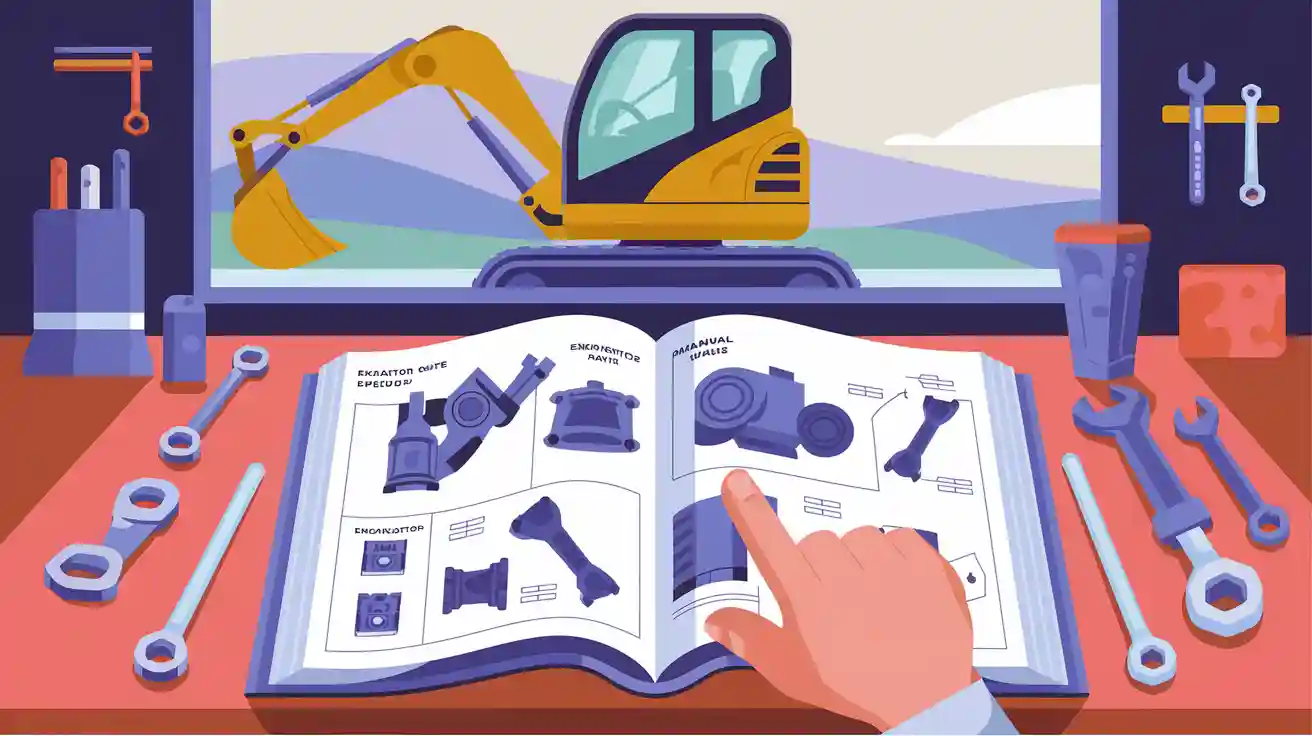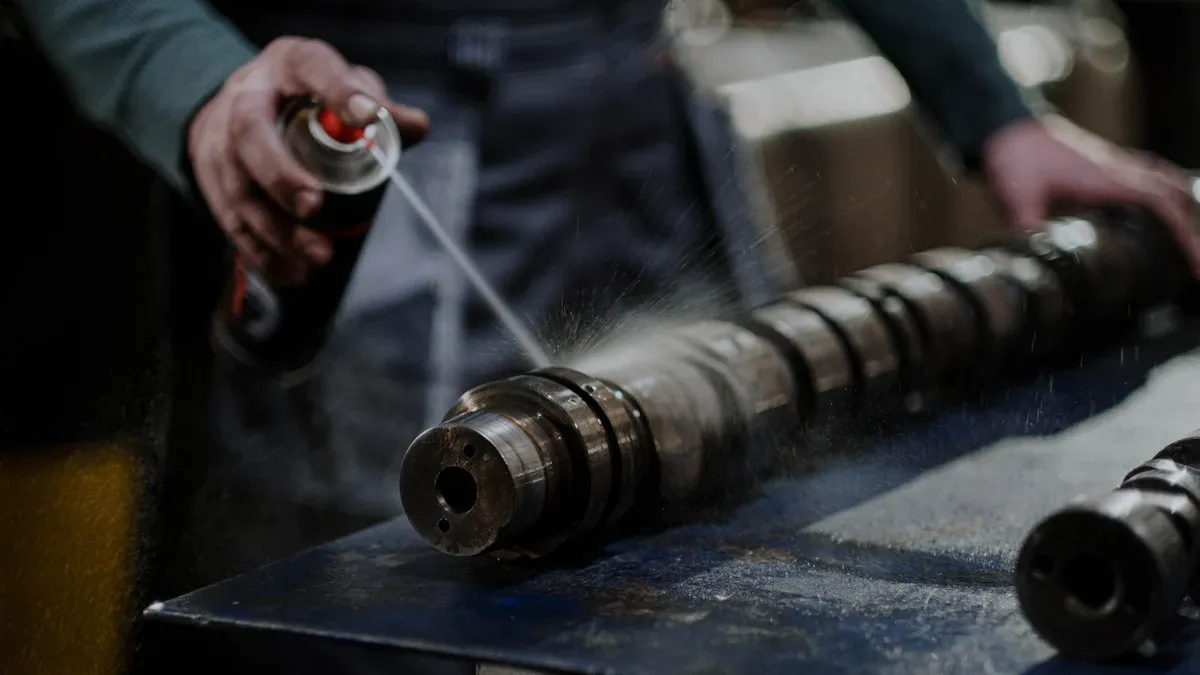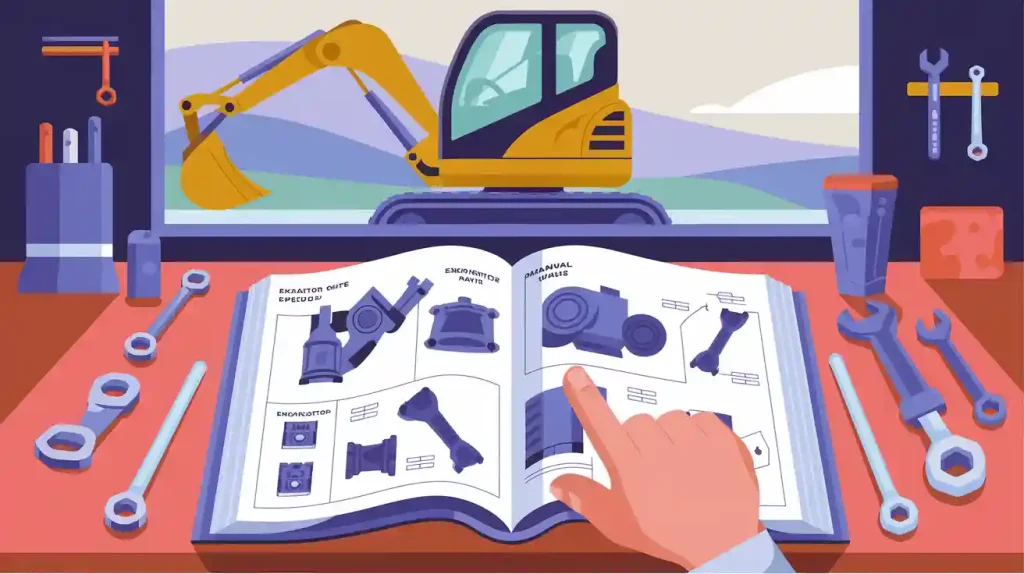
A detailed Hitachi excavator parts manual plays a vital role in keeping your equipment in top condition. It helps you identify components, perform maintenance, and carry out repairs efficiently. However, navigating these manuals can sometimes be challenging. Common issues include difficulties with catalog structure and navigation or verifying the authenticity of parts.
Challenge Type | Description |
|---|---|
Catalog Structure and Navigation | Evaluation of the digital catalog’s usability, including search algorithms and categorization systems. |
Parts Authentication and Counterfeiting | Highlighting the issues of counterfeit parts and authentication measures. |
By understanding these challenges, you can better utilize the manual to ensure your excavator operates smoothly. A well-organized and user-friendly manual saves time and prevents costly mistakes.
Key Takeaways
A good parts manual saves time and avoids expensive errors.
Use the contents page and index to find sections fast.
Clear pictures with labels help you spot parts and their spots.
Follow simple repair steps to avoid mistakes and work faster.
Keep the manual nearby to check part numbers and fit easily.
Organization and Layout in a Hitachi Excavator Parts Manual
Logical Structure for Easy Navigation
Comprehensive Table of Contents and Index
A well-structured Hitachi excavator parts manual begins with a detailed table of contents. This feature allows you to locate specific sections quickly, saving time during maintenance or repairs. A comprehensive index at the end of the manual further enhances usability by listing all key terms and part names alphabetically. For example, if you need to find information about the hydraulic system, the index directs you to the exact page. This logical organization ensures you can navigate the manual efficiently, even under time constraints.
Section Divisions for Key Components
Dividing the manual into sections based on major components, such as the engine, hydraulics, and electrical systems, simplifies your search for information. Each section should focus on a specific area of the excavator, providing detailed descriptions and diagrams. For instance, the Hitachi EX60 product parts manual often includes separate sections for engine parts and hydraulic assemblies. This structure ensures you can easily identify and understand the parts relevant to your excavator model.
Consistent Formatting Standards
Use of Headings, Subheadings, and Numbering
Consistent formatting plays a crucial role in making the manual user-friendly. Clear headings and subheadings help you identify topics at a glance. Numbering systems, such as sequential part numbers or step-by-step instructions, provide clarity and prevent confusion. For example, a service manual for genuine Hitachi parts might use numbered steps to guide you through replacing a specific component.
Page Numbering for Quick Reference
Page numbering is another essential feature of a well-organized parts catalog. It allows you to cross-reference sections and locate information quickly. Industry standards for technical manuals recommend single spacing, left justification, and a readable font like Arial or Calibri for electronic versions. These formatting choices ensure the manual remains clear and professional, even when viewed on a screen.
By focusing on logical structure and consistent formatting, a Hitachi excavator parts manual becomes an invaluable tool. Whether you are referencing the parts catalog or performing maintenance, these features make the process straightforward and efficient.
Content Clarity and Accessibility
Clear Descriptions and Instructions
Avoiding Overly Technical Jargon
A good parts manual avoids overwhelming you with complex technical jargon. Instead, it uses simple words and short sentences to explain concepts clearly. For example, rather than saying “hydraulic actuator malfunction,” the manual might state “the hydraulic arm is not moving properly.” This approach ensures that even if you are not a technical expert, you can still understand the information. Manuals that include real-world examples also help you apply the instructions effectively. For instance, a service manual might describe how to replace a damaged hydraulic hose by comparing it to connecting a garden hose. These relatable examples make the content easier to grasp.
Step-by-Step Guidance for Part Replacement
Step-by-step instructions are essential for performing repairs or maintenance on your excavator. A well-written Hitachi excavator parts manual provides clear, numbered steps for replacing components. For instance, if you need to replace a fuel injector, the manual might guide you through each stage, from locating the injector to securing the new one in place. This structured approach minimizes errors and ensures you complete the task efficiently. Including diagrams alongside these instructions further enhances clarity, allowing you to visualize each step as you follow along.
Language and Usability Features
Glossary of Technical Terms
A glossary is a valuable feature in any parts catalog. It defines technical terms and acronyms, ensuring you understand the language used throughout the manual. For example, if the manual mentions “OEM” (Original Equipment Manufacturer), the glossary explains what it means and why it matters. This feature is especially helpful if you are new to working with Hitachi equipment or unfamiliar with certain terms. A glossary also ensures consistency in terminology, reducing confusion when you encounter the same term in different sections.
Availability of Translations or Simplified Terms
If English is not your first language, a manual with translations or simplified terms can make a significant difference. Many Hitachi manuals include translations in multiple languages, ensuring accessibility for a global audience. Simplified terms also help you understand complex concepts without needing advanced technical knowledge. For example, instead of “torque specifications,” the manual might say “tightening instructions.” This focus on usability ensures that you can use the manual effectively, regardless of your language proficiency.
Tip: Look for manuals that include appendices or indices. These features enhance usability by providing supplementary content and making the manual a valuable reference tool.
Part Identification and Compatibility

Understanding Part Numbers and Descriptions
Locating Part Numbers in the Manual
Locating part numbers in a Hitachi excavator parts manual is essential for identifying the correct components for maintenance or repairs. You can usually find these numbers listed alongside detailed diagrams, specifications, and photographs of the parts. These visuals serve as a crucial resource, helping you match the part number with the actual component on your excavator. Accurate identification minimizes risks, such as using incorrect parts, which could lead to costly repairs or safety issues. Always ensure the part number aligns with the description provided in the manual to avoid confusion.
Cross-Referencing Part Numbers with Diagrams
Cross-referencing part numbers with diagrams in the parts catalog ensures you select the right component. For example, if you are working on the hydraulic system, the diagram will show the exact placement of each part, along with its corresponding number. This method helps you verify that the part you are ordering matches the one required for your excavator. A well-designed Hitachi EX60 product parts manual often includes exploded views of assemblies, making it easier to identify and cross-check parts.
Ensuring Compatibility with Your Excavator Model
Identifying Parts for Specific Models like Hitachi EX60
Ensuring compatibility with your excavator model requires careful attention to detail. For instance, when sourcing parts for a Hitachi EX60, you should confirm that the part number matches your machine’s specifications. Many online platforms, such as AliExpress, provide part numbers that you can cross-reference with your manual. This step ensures the part fits your model and functions as intended. Additionally, always consider the quality of the components to maintain the performance of your excavator.
Notes on Interchangeable Parts
Interchangeable parts can simplify repairs, but identifying them comes with challenges. Factors like economic disparities, regulatory compliance, and counterfeit parts can complicate the process.
Challenge | Description |
|---|---|
Economic Disparities | Fluctuations in labor and material costs across countries affect pricing and vendor choices. |
Regulatory Compliance | Different regions have varying safety and operational standards, necessitating specialized knowledge. |
Counterfeit Parts | The rise of counterfeit parts complicates the identification of genuine components. |
To avoid these issues, always cross-reference product descriptions with your original equipment manufacturer’s guidelines. This practice ensures you select genuine Hitachi parts that meet the required standards.
Tip: Keep your parts manual accessible during maintenance. It helps you quickly verify part numbers and compatibility, saving time and reducing errors.
Diagrams and Illustrations in a Hitachi Excavator Parts Manual

Detailed and Accurate Visuals
Exploded Views of Assemblies
Exploded views in a parts manual provide a clear and detailed breakdown of complex assemblies. These diagrams separate components visually, showing how each part fits together. For example, when working on the hydraulic system of your excavator, an exploded view helps you identify individual components like seals, pistons, and valves. This visual clarity ensures you can locate damaged parts quickly and understand their placement within the system. By simplifying complex assemblies, these diagrams make repairs and maintenance more manageable.
Labeled Diagrams for Easy Identification
Labeled diagrams enhance usability by clearly marking each component with its name or part number. This feature allows you to cross-reference parts with the descriptions in the manual. For instance, if you are using a Hitachi EX60 product parts manual, labeled diagrams help you confirm the exact part required for your model. Consistent labeling also reduces errors during part replacement, ensuring you select the correct component every time.
Placement and Quality of Diagrams
High-Resolution Images for Clarity
High-resolution images in a parts catalog improve the overall quality of the manual. Clear visuals allow you to see intricate details, such as the texture or shape of a component. This level of detail is especially useful when identifying genuine Hitachi parts. For example, a high-resolution photograph of a fuel injector helps you visually confirm its compatibility with your excavator. Clear images also make it easier to distinguish between similar-looking parts, reducing the risk of mistakes.
Diagrams Positioned Near Corresponding Text
Placing diagrams close to their related text ensures you can easily follow instructions without flipping through multiple pages. For example, if the manual explains how to replace a hydraulic pump, the corresponding diagram should appear on the same page or directly adjacent. This layout improves efficiency by allowing you to reference both the text and the visual simultaneously. Manuals with this thoughtful design save time and reduce frustration during maintenance tasks.
Tip: Look for manuals that maintain consistency in shapes, colors, and formatting across diagrams. This approach enhances readability and ensures you can quickly locate the information you need.
Feature | Benefit |
|---|---|
Detailed diagrams | Provide clear visual representations of components for easy identification of damaged parts. |
Specifications | Offer precise information about each part, aiding in accurate ordering. |
Photographs | Help users visually confirm the correct parts needed for maintenance. |
Effective diagrams and illustrations in a Hitachi excavator parts manual simplify complex concepts and improve usability. They ensure you can identify, order, and replace parts with confidence, keeping your equipment in top condition.
Additional Resources and Support from YNF Machinery
Troubleshooting and Maintenance Guides
Common Issues and Their Solutions
You may encounter various challenges while maintaining your Hitachi excavator. A reliable manual often includes troubleshooting guides to address these issues effectively. For example, disassembly and assembly procedures are detailed to help you avoid mistakes that could lead to personal injury. Maintenance precautions, such as inspecting the machine and recording specific details, ensure you prevent recurring problems. Hydraulic system issues, like air trapped in the system, are also covered with step-by-step instructions to protect critical components. These guides save time and reduce the risk of costly errors during repairs.
Tip: Always follow the recommended procedures in your service manual to ensure safety and accuracy during maintenance tasks.
Maintenance Schedules for Excavator Engine Parts
Effective maintenance planning is essential for keeping your excavator in top condition. A parts manual typically includes schedules for tasks like filter changes, lubrication, and fluid replacements. For instance, you should change filters every 250 to 500 hours to maintain clean air and fluid circulation. Lubrication every 50 to 100 hours reduces friction and extends the lifespan of components. Regular inspections, performed every 250 to 500 hours, help you identify wear or damage early.
Maintenance Task | Frequency | Purpose |
|---|---|---|
Filter Changes | Every 250 to 500 hours | Ensures clean air, fluid, and fuel circulation, protecting components. |
Lubrication | Every 50 to 100 hours | Reduces friction and wear, extending component lifespan. |
Fluid Changes | Engine oil: 250 to 500 hours | Protects against wear and maintains optimal temperatures. |
Component Inspections | Every 250 to 500 hours | Identifies wear or damage, enabling timely repairs. |
By adhering to these schedules, you can minimize downtime and extend the life of your equipment.
Support and Contact Information
Manufacturer Support Details
YNF Machinery provides comprehensive support to ensure you find the right parts for your Hitachi excavator. You can rely on their knowledgeable team for expert advice and assistance. All parts come with a 12-month warranty, giving you peace of mind about their quality. Fast shipping options, including free shipping to the Mainland United States and the United Kingdom, ensure you receive your parts promptly.
Note: Contact YNF Machinery’s support team for guidance on selecting compatible parts for your specific excavator model.
Links to Online Resources, Including YNF Machinery’s Website
Online resources can enhance your understanding of Hitachi parts manuals and maintenance planning. For example, the Hitachi EX120 parts manual provides detailed diagrams and part numbers, making it easier to identify and procure replacement parts. Similarly, the Hitachi Ex270 Ex270lc Excavator Parts Catalog offers insights into maintenance schedules and troubleshooting guides. YNF Machinery’s website also serves as a valuable resource, offering a wide range of high-quality parts and expert support.
Utilizing these resources can significantly reduce downtime and costs. For instance, a construction company once identified a faulty boom using a parts catalog and completed repairs within 24 hours, avoiding project delays. This demonstrates the practical benefits of having access to detailed manuals and reliable support.
Visit YNF Machinery’s website: YNF Machinery Official Website
A Hitachi excavator parts manual is an indispensable tool for maintaining your equipment. Key elements to focus on include:
Component identification systems
Catalog structure and navigation
Availability and inventory management
Parts authentication and counterfeiting
To use the manual effectively, bookmark important sections for quick access. This reduces downtime, enhances safety, and streamlines the ordering process. Organize the manual logically, group related data, and rely on diagrams for clarity. These practices ensure efficient maintenance and repairs.
For high-quality excavator engine parts and assemblies, trust YNF Machinery. Their extensive product range and expert support make them a reliable partner for your equipment needs.
FAQ
1. How do you identify the correct part number in a Hitachi excavator parts manual?
You can locate the part number by referring to the diagrams and descriptions in the manual. Cross-check the number with the component’s specifications to ensure accuracy. This process helps you avoid ordering the wrong part.
2. Why are exploded diagrams important in a parts manual?
Exploded diagrams visually break down complex assemblies into individual components. They help you understand how parts fit together and make it easier to identify damaged or missing pieces. These diagrams simplify repairs and maintenance tasks.
3. Can you use aftermarket parts with Hitachi excavators?
Yes, you can use aftermarket parts if they meet or exceed OEM standards. Always verify compatibility with your excavator model by consulting the parts manual or contacting a trusted supplier like YNF Machinery.
4. What should you do if a part is unavailable in the manual?
If a part is missing from the manual, contact the manufacturer or a reliable supplier like YNF Machinery. They can assist you in identifying and sourcing the correct component for your excavator.
5. How often should you update your parts manual?
You should update your parts manual whenever you upgrade or modify your excavator. Keeping the manual current ensures you have accurate information for maintenance and repairs, reducing downtime and errors.
Tip: Always keep your parts manual accessible during maintenance. It saves time and ensures you use the correct components for your excavator.





